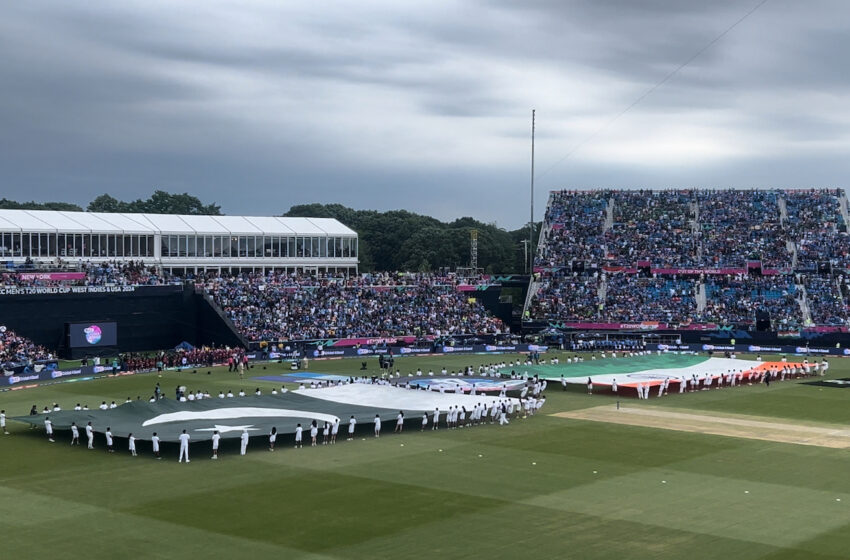Cricket in Big Apple: A tale of slow and late starts, and grand finishes

Another India-Pakistan showdown for the ages as temporary stands and a whirlwind construction timeline couldn’t stop New York from hosting thrilling T20 World Cup matches.
LONG ISLAND, N.Y.: The modular stands of Nassau County International Cricket Stadium, which hosted eight Men’s T20 World Cup matches, were set to be demolished soon after Shivam Dube hit the winning run against cohosts United States. The drop-in pitches, an Australian import, will also be gone soon, with concrete pitches taking their place. However, the rest of the playing arena will remain intact, as a monument to the first-ever global cricket tournament held on U.S. soil, where baseball, the game’s younger cousin, reigns supreme.
Notwithstanding widespread complaints about the pitch, several matches held in New York were entertaining. There was plenty of drama and excitement, as evidenced by the thrilling India-Pakistan match and the nail-biting South Africa-Bangladesh contest.
They proved that cricket doesn’t need flat tracks to be competitive. American fans embraced the tournament, and several U.S. businesses supported it. There are two caveats though: nearly all spectators were immigrants from cricket-playing nations, and the companies that spent big dollars to buy tickets and advertise were those connected with India.
There were grumblings galore when New York was picked as one of the three U.S. venues to host the World Cup. Unlike Grand Prairie, Tex., and Fort Lauderdale, Fla., New York did not have a cricket stadium. To make matters worse, the construction of the temporary stands began awfully late, with the stadium design finalized only 137 days before the scheduled start of the first match.
READ: Celebrating cricket’s American Dream at State Department (June 14, 2024)
Yet, the eight matches played at the venue went off very well, except for the fact that all of them were low-scoring affairs.
Now, as the tournament moved to Florida and the Caribbean, one can safely say that cricket is better off for having chosen New York — arguably the most diverse city in the world — as one of the venues to host its World Cup in its shortest format, and New York — the city of immigrants — is better off for having hosted part of a global tournament of the planet’s second-most popular sport.
Without question, the marquee match was the India-Pakistan showdown, often seen as “war by other means” in the minds of many on both sides.
* * *
These days, an India-Pakistan match in a World Cup may not be the gladiatorial contest it once was. With India winning six of the seven matches the two have played on the world stage, it’s more reminiscent of the One Day Internationals in Sharjah during the 1980s and ’90s, when Pakistan used to win almost every contest between the two neighbors.
Yet, whether they play in Dubai, Melbourne, or Ahmedabad, their face-off is never without hype. The Big Apple has a knack for elevating everything sky-high, so when the match was played in New York, it was a given that it would be treated as a Super Bowl-type event. The New York Post, Rupert Murdoch’s tabloid, called it “perhaps the greatest sports rivalry in the world.”
Despite predictions of clear skies from usually reliable weather apps, many spectators were still nervous about whether rain would play spoilsport. Their fears were not unfounded, as the match started 50 minutes late due to rain. And just when the game seemed to get underway, there came an interruption after only one over.
You could not blame the spectators for their disappointment. Many had paid thousands of dollars for premium tickets and flown in from different parts of the United States and Canada. As well-traveled cricket fans in the crowd drew analogies to rain-affected matches they had watched at Lord’s or the Premadasa Stadium in Colombo, many attending their first international match were nervous.
* * *
For the India-Pakistan match, the Nassau County International Cricket Stadium had the atmosphere of Wankhede and a Feroz Shah Kotla, rather than a neutral venue, which, in theory, it was meant to be. Indian fans outnumbered Pakistani fans by probably 20 to 1.
Prakash Mehta, a partner at the law firm Akin Gump Strauss Hauer & Feld LLP., summed it up best, “The Dutch staked their claim for New York 500 years ago. Since then everybody had a piece of New York. It is nice to see, in the past few days, Indians staking claim to New York.”
READ: Beautiful game of cricket to further ties with South Asia (June 7, 2024)
As for the match itself, the cricket on display was not the high-scoring, fast-paced Indian Premier League variety but more akin to traditional one-day cricket of the 1980s when a run rate of 6 runs per over was considered daunting. Although it wasn’t intentionally designed this way, in the spirit of American fairness, bowlers had an equal or even greater impact on the proceedings.
One bowler who particularly stood out was Jasprit Bumrah. In a “New York Minute,” he dramatically shifted the game’s momentum by bowling Mohammad Rizwan out in the 15th over of Pakistan’s chase of 120. The diminutive wicket-keeper batsman, the most solid batter in an otherwise brittle Pakistani batting lineup, attempted a cross-bat shot in a spectacular moment of madness. But this was destined to be Bumrah’s moment.
For 18 years, from 1995 to 2013, New York City was “owned” by Mariano Rivera, the closer who pitched for the New York Yankees in the Bronx, roughly 30 miles west of Nassau County International Cricket Stadium. But on June 4th, the man who owned the Big Apple was the Indian slinger who goes by the nickname “Boom Boom.”
(Asif Ismail is the publisher of DesiMax.)
